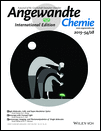Hypoxia Induced by Upconversion-Based Photodynamic Therapy: Towards Highly Effective Synergistic Bioreductive Therapy in Tumors†
This work has been financially supported by the National Natural Science Foundation of China (Grant No. 51372260, 51132009, 21172043, 31370838), and the Scientific Research Foundation for the Returned Overseas Chinese Scholars from China State Education Ministry (No. N130204). Thanks to Linlin Zhang, Heliang Yao, Huaiyong Xing, Wenpei Fan, Zhaowen Cui, and Feng Chen from Shanghai Institute of Ceramics, Chinese Academy of Sciences for useful discussions.
Graphical Abstract
Synergetic therapy: Strong hypoxia created by upconversion photodynamic therapy (UC-PDT) activates bioreductive pro-drugs co-delivered to form cytotoxic species, thereby potentiating the synergetic anticancer efficacy of UC-PDT. This process was accomplished by using upconversion-based nanoparticles designed to simultaneously deliver photosensitizer molecules and bioreductive pro-drugs in silica layers.
Abstract
Local hypoxia in tumors is an undesirable consequence of photodynamic therapy (PDT), which will lead to greatly reduced effectiveness of this therapy. Bioreductive pro-drugs that can be activated at low-oxygen conditions will be highly cytotoxic under hypoxia in tumors. Based on this principle, double silica-shelled upconversion nanoparticles (UCNPs) nanostructure capable of co-delivering photosensitizer (PS) molecules and a bioreductive pro-drug (tirapazamine, TPZ) were designed (TPZ-UC/PS), with which a synergetic tumor therapeutic effect has been achieved first by UC-based (UC-) PDT under normal oxygen environment, immediately followed by the induced cytotoxicity of activated TPZ when oxygen is depleted by UC-PDT. Treatment with TPZ-UC/PS plus NIR laser resulted in a remarkably suppressed tumor growth as compared to UC-PDT alone, implying that the delivered TPZ has a profound effect on treatment outcomes for the much-enhanced cytotoxicity of TPZ under PDT-induced hypoxia.





